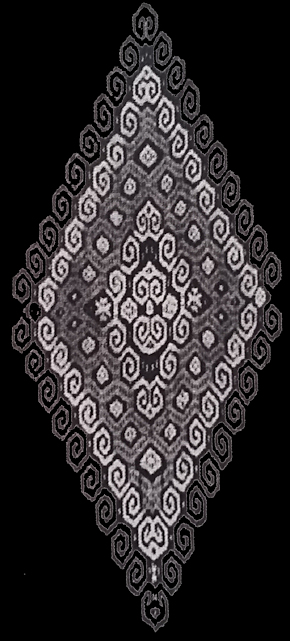| |
 
 | | | |
296 Timor, West Timor
Mau'ana (shawl)  
| | Locale: | Molo, else probably Amanuban Barat, more specifically Nusa, where such large motifs were more common than elsewhere in the region | | Period: | Ca. 1950 | | Yarn: | Cotton, commercial, fine, double-ply | | Technique: | Warp ikat and buna | | Panels: | 1 | | Size: | 44.5 x 182 cm (1' 5" x 5' 11") LW: 4.09 | | Weight: | 283 g (10.0 oz), 349 g/m2 (1.14 oz/ft2) | | Design: | Field divided in three longitudinal sections, the outer two decorated in warp ikat, the central one in buna. An overall design consisting of an array of lozenges overrides the vertical division: the lozenges made in ikat and those made in buna project into each other, respectively receive an intrusion. This visual device fuses the component elements, as is also often done on the grips of daggers. The lozenges with their curly inward and outward hooks are kaif motifs, which stand for connection to the ancestors. The design works very well on its own, but given its length this cloth may also have been intended as the middle panel of a mau, men's blanket. | | Comment: | This cloth may well have been made for the court of Molo, where no ikat is practiced: it came with a Molo provenance and Yeager and Jacobsons show a member of Molo's royal family wearing a sarong with very similar ikat. Such 'foreign' textiles - made in a technique not locally mastered - probably enjoyed a particular esteem. Many of the ikat motifs are extremely fine: merely two yarns wide. As it appears that the cloth was made with a fourfold repeat of the basic ikated motif, this would imply bindings wrapping skeins of only eight threads, putting this cloth in finest category of ikat weavings in the Indonesian archipelago. Buna, discontinuous supplementary weft, is a labour intensive warp wrapping technique that produces no 'bad side': because the ends of the wrapped yarn are cleverly hidden, both sides are equally beautiful. Ex collection August Flick. | | Background: | Chapters on Timor and West Timor. | | Exhibited: | Timor: Totems and Tokens, Museu do Oriente, Lisbon, 2019/20. | | Published: | Timor: Totems and Tokens, 2019.
Ikat Textiles of Timor: Indonesian and Timor-Leste, 2025. | | Compare: | 172 | | Sources: | The combination of ikat and buna is similar to that on a sarong shown in Hamilton and Barrkman, Textiles of Timor, Fig. 2.28. Amanuban ikat at court of Mollo in Yeager & Jacobson, Textiles of Western Timor, Fig. 107. Comments partly based on information provided by Timor textile expert Pierre Dugard. Dugard's extensive, as yet largely unpublished, documentation of Timorese designs includes the below drawing of a motif that many would attribute to Amanuban, but that was recorded in Konbaki, southern Molo.
 | | |

©Peter ten Hoopen, 2024
All rights reserved.
|
|


